|
8.1 Objectives
This Lab contains 2 parts. In Part A, to be done in lab, you will:
- Create a Digital Elevation Model from LiDAR LAS files
- Construct a Geodatabase that can be updated
by field observations;
- Print map layouts and instructions for data collection to take with you to the field;
- Export your project to an ArcPad v.10 project;
In Part B, to be done during the following lecture period, you will:
- Learn procedures for capturing GPS points, lines and polygons with ArcPad
10 software;
- In pairs, practice with a Trimble Nomad GPS receiver capturing
the locations of polygons and lines on the Campus Main Building Mall.
8.2 The Problem and the Data
The
Mason Mountain Wildlife Management Area (hereafter WMA),
administered by the Texas Parks and Wildlife Department, is a
state-owned, ~5300 acre former ranch principally dedicated to studying
animal husbandry of "super exotic" African ungulates (Oryx, Kudu,
Water Buck, etc.) in a Hill Country habitat. Research into the
ecology of the "central Texas Mineral Region" (a.k.a. Llano Uplift) and
applications to wildlife management practices are also conducted there.
Access is restricted; entry is by permission only. Geologically,
the WMA is situated near the boundary of the western Llano uplift
(Figure 1), where erosion of Cretaceous carbonates (green in Fig. 1) of
the Edwards Plateau has exposed older Paleozoic and Precambrian rocks
(blue and pinks in Fig. 1) of the Llano Uplift beneath. The wide
variety of rocks exposed here and extensive outcrops of the Precambrian
granite of the Katemcy Pluton (Fig. 2) make this a nice location for
studying the geologic history of the uplift and the products and
processes associated with magmatic intrusions.
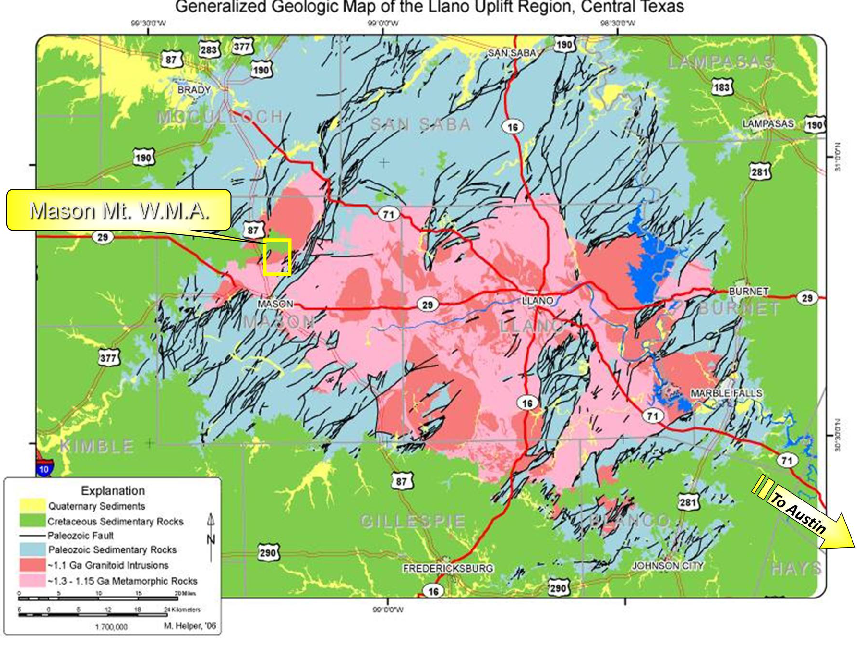
Figure 1. Generalized geologic map of the Llano Uplift region, showing
the location of the Mason Mountain Wildlife Management Area in Mason
County.
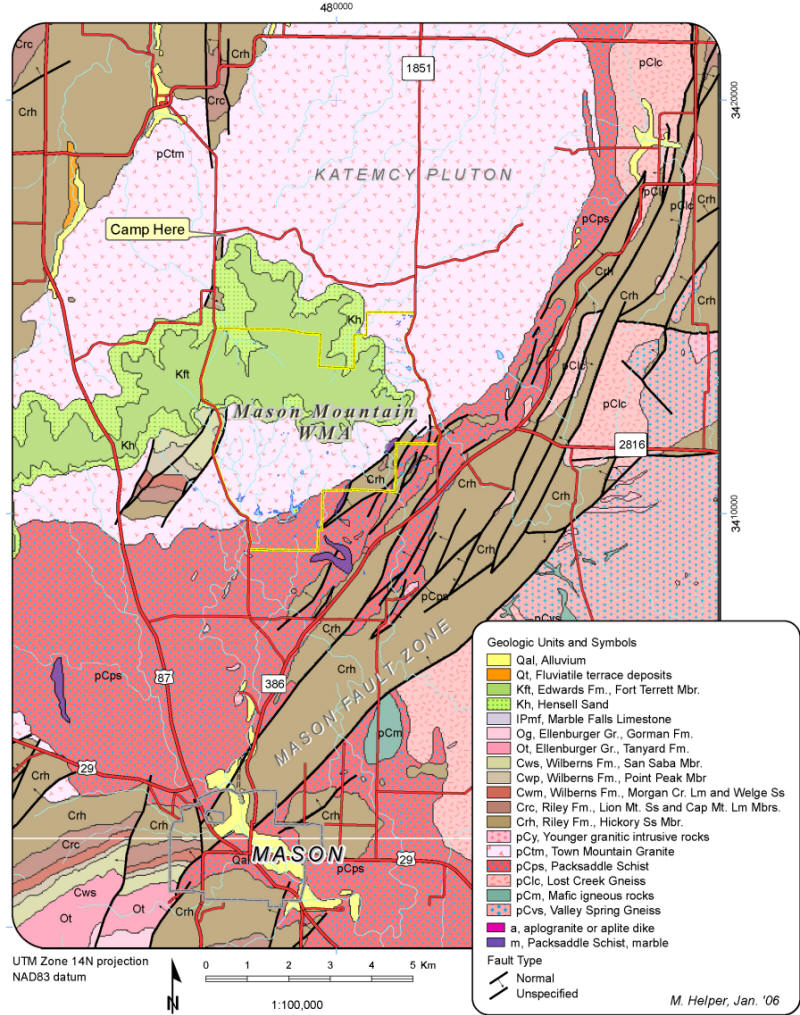
Figure 2. Generalized geologic map (data from Geologic Atlas of
Texas, Lllano Sheet) of the Mason, TX area, including the WMA. We
will not be camping in the location shown on this map.
The goals of our weekend field trip are to two fold:
-
Map the distribution of Precambrian
rock outcrops. These cannot be mapped with high
fidelity from areal photographs because of masking by
vegetation, but are easily recognized from bare earth
Lidar digital terrain models (more below). The
digital outlines of outcrop polygons allows for, among
other things, an accurate estimate of the area underlain
by vegetation vs. rocks within some of the high-fenced
pastures of the WMA. This is an important
statistic for game management studies. Subtracting
the sum of the rock polygon areas from the total pasture
areas will give this statistic.
-
Map and measure the orientation of
fracture/joint sets and planar dikes in granite. Note
relative ages where possible. These data are needed to
better address questions about the age and orientation of
stresses responsible for extensive fracturing near the
southern margin of the Katemcy Pluton. Our high
resolution Lidar terrain models will reveal a pattern, but
field data are required to interpret it.
Data
The GIS lab portion (Part A) uses the following data:
- UTM zone 14 NAD83, LAS-format, Airborne LiDAR files acquired during
flights in 2007, provided by the Texas Natural Resources
Information Service (TNRIS). These were
ordered and collected from their Austin office for
the cost of a 50 Gb flash drive;
- a UTM zone 14 NAD83, 0.5 meter-resolution,
2008-2009 digital orthophoto (NW quarter of the Purdy
Hill Quad.) from
TNRIS;
- Shapefiles of rock units, faults,
contacts, roads, fences, etc., some created by David
Kilventon for his 2006
senior
thesis map of the WMA, others from my own work;
- edited NAD83 National Hydrological Dataset (http://nhd.usgs.gov)
) files for water bodies, springs and flow lines
**Download the Lab_7_data folder to your flash drive,
NOT YOUR NETWORK STORAGE.** This file contains over 4 Gb of data and
may take up to 5 minutes to download.
8.3 Working with LiDAR data in ArcGIS
LiDAR data are fundamentally clouds of points ("point clouds") with
XYZ coordinates and attributes. They are commonly stored and distributed in LAS (LASer)
format files, a non-propriety format that has gained
wide acceptance in recent years. ArcGIS have extensive tools for importing and
working with LAS files. Our goals for this part of the lab are to:
- Import LAS files into ArcGIS and examine their
properties
- Create a raster digital terrain model ("DTM") from
these vector files
- After checking to be sure that the Spatial Analyst
and 3D Analyst Extensions are checked on in a blank
ArcMap document, open the ArcCatalog window
inside of ArcMap, right-click on the Lab_7_data "LiDAR"
folder and select "New", create a "LAS Dataset" and
rename it MMWMA.lasd. This creates a container
into which we can import LAS files. A "LAS
Dataset" (.lasd) has special properties that allow us to
examine some of the unique features of LiDAR data and is
required for some LAS processing tools.
- Add the six LAS files (each is a tile of a single large
area and has a file name that ends with .las) to this new LAS Dataset by right-clicking on
the LAS
Dataset icon, selecting "Properties...", the "LAS Files" tab
and the "Add Files..." button (shown below).
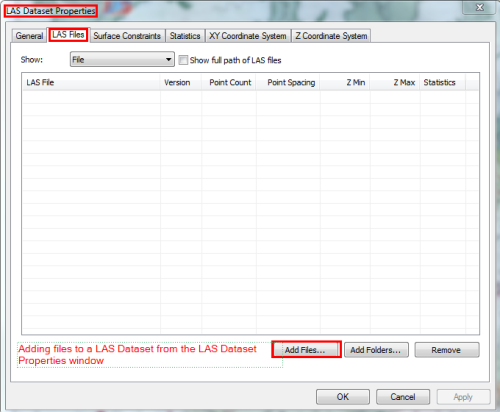
- Examine the Properties of the imported
files. Note that each file contains 26 million points
- we will be working with over 150 million points in this
exercise (!) - that are spaced at about 0.63 meters (as
shown below). The maximum (Z Max) and minimum (Z
min) elevation of the points in each file is also
listed.
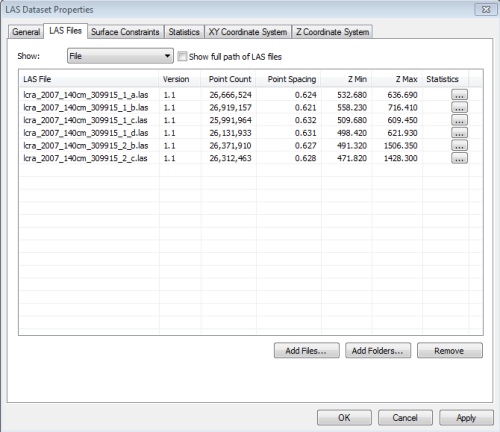
- Open the "Statistics" tab and click
the "Calculate" button - this may take some time...
there are over 26 million points (!) in each of the
files.
- As shown below, the result provides
Statistics on two important parameters. This will be
important later - pay attention as you read on...
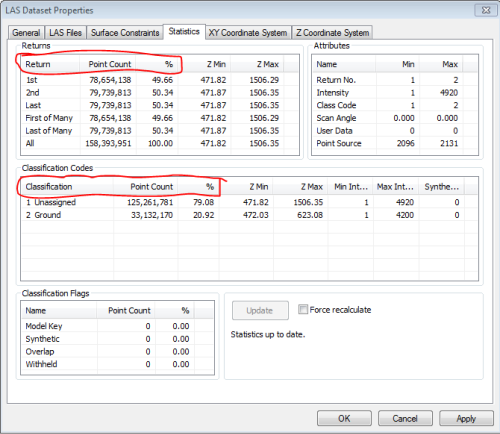
LiDAR data consist of multiple "Returns" (upper left
table): light pulses
that bounce back to the instrument. A "return" is a specific arrival at the instrument
from a single laser pulse. For each pulse, these are
classified by whether they return quickest ("First returns") or at
successively later times (Second, Third, Forth, etc.). As
shown in the statistic table, of the 158,393,951 returns, about 50% are first returns
(also classed as "First of Many") and 50% are later ("2nd", "Last",
"Last of Many"). More recently acquired data will often contain a
more detailed classification of returns - these 2007 data, in LAS 1.1
format (see first table), contain only two classifications, making them
less useful for some applications.
During post-processing, most returns are
assigned a standard Classification Code (middle table) based on the origin of the return. The
distinction between return number (i.e first, second, etc.) and Classification code is important - it is easy
to understand that for partially vegetated areas some first returns will
come from the ground whereas others will from the tops of trees. We are interested
in returns that are classified as ground returns - coded 2. For this
dataset, points with ground returns are least abundant (~21% of all data); note that
all other returns (~79%) are "Unclassified" (code 1). Again, more
recent datasets commonly contain classification for 4 or more additional
categories: i.e. water, vegetation, buildings, etc.
The strength or Intensity of returns (middle table) are also measured
(on a scale of 0 to 65,535) - some pulses come back strong, some weak.
Strong returns come from highly reflective surfaces, weak from surfaces
that absorb some of the laser pulse. Minimum and Maximum Intensity
measurements are listed for each classification.
-
Click "OK" to store the statistics.
-
Drag the MMWMA LAS Dataset from ArcCatalog
into a blank Arc Map window. You have just loaded
the entire point cloud, all ~158 million points!
-
ArcMap shows only the
red outlines of each of the six data tiles (this keeps
redrawing times reasonable) until you zoom to a specific
area.
- Zoom into the lower right corner (at
a scale of 1:10,000 or greater) of the upper middle
tile. Your screen should look similar to image
below. You are looking at a two dimensional view
of a point cloud, color coded by elevation - the ArcMap
table of contents shows the range of elevations (in
meters) represented by each color. White
represents areas of no points.
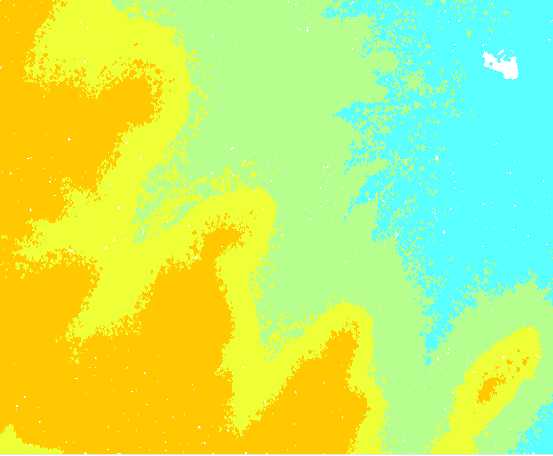
- Open the LAS Dataset toolbar (Customize>Toolbars>LAS
Dataset), which contains a variety of options for
viewing and manipulating point clouds.

If the toolbar is grayed-out, you will have to turn on
the Spatial and 3D analysts extensions, as indicated in
the step 2 above.
-
Want to see something astounding? Use the Profile Tool (second
from right on the LAS Dataset toolbar) to construct a
short vertical profile (a cross section) through the point
cloud. A tool tip, visible when hovering the mouse
over the tool, explains how. These are unfiltered points, so we are
viewing returns irrespective of Code Classification
(tree tops clearly visible!).
We won't spend much time with this tool but it's just too
cool to ignore!
Explore the other tools on
this toolbar - they provide very powerful ways to view
and interactively filter LAS point clouds. If they
don't seem to work, try sampling a smaller area.

- Can't resist one more trick with this toolbar...
create a surface elevation model (a TIN) with the Elevation tool
on the toolbar (see below) by zooming in or out of your
Map.
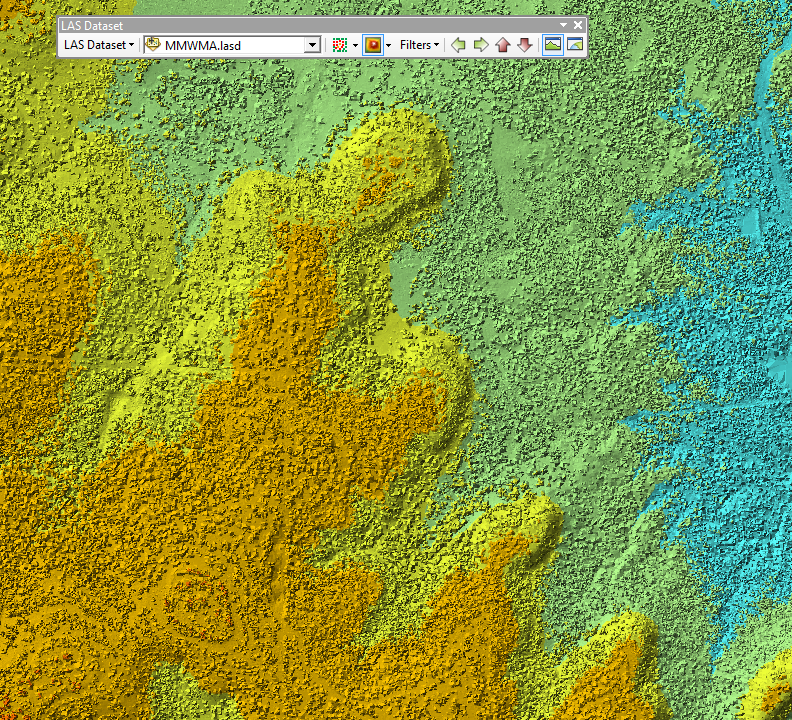
The maps/profiles created with the LAS Dataset toolbar are
visualizations created on-the-fly, not permanent products. As
such, they are of limited use for analysis. We would like to
create a permanent raster dataset from this LiDAR (vector)
point cloud - specifically a high resolution, "bare earth" Digital
Elevation Model (DEM; nomenclature varies - LiDAR-derived bare earth
rasters are commonly referred to instead as Digital Terrain Models (DTMs)).
This will require a tool from ArcToolbox.
- Using the Search window in ArcMap, search "LAS to
Raster" for the tool needed for this conversion.
- IMPORTANT - Before running this tool make sure a)
that you are zoomed completely out and can see the red
outlines of all of the data tiles in ArcMap; b) that the LAS Dataset
Toolbar has the "Filters" tool drop-down set to "Ground" and the
Point tool drop-down set to "Elevation". These choices
will be recognized by the "LAS Dataset to Raster" tool
in ArcTool box if we take care to choose the ArcMap
layer as the Input Dataset and not browse to and choose
the original LAS Dataset.
- Open the "LAS Dataset to Raster" tool from
ArcToolbox or the Search window. If not already
shown, show the Help for this tool. USING THE DROP-DROWN
ARROW AND NOT THE FOLDER ICON (see graphic below),
select MMWMA.lasd as the Input the LAS Dataset
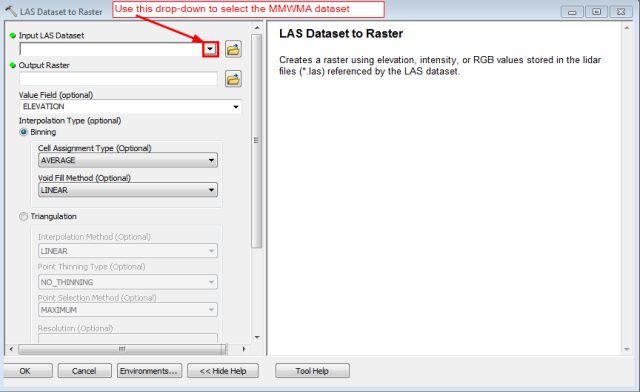
- name your output raster MMWMA_DTM, to be
stored in your LAS_WMA_2007 folder of Lab_7_data folder
- Value
Field is ELEVATION,
- Interpolation Type is Binning with
"MINIMUM" (this is a bare earth model...) as the Cell
Assignment Type and NATURAL_NEIGHBOR as the Void Fill
Method.
- DO NOT CLICK OK YET -we
need to specify the raster resolution (cell size), which
requires some thought. The raster cell size should
never be smaller than the point spacing of returns.
As seen in the statistics, the average return spacing is
about 0.6 meters. This is for all returns,
irrespective of classification. We are using Class
2 (ground returns) only, not all points, so the spacing
for these returns may be significantly greater (3x to 4x
greater- not all points will have ground returns). A conservative approach for a bare earth DTM is to set the raster cell size to ~ 3 times the
average return spacing. For our data this means
about a 2 meter cell size, SO SET THE "Sampling Value" TO 2.
- Z Factor is 1. Click OK. This will take a few minutes...
If all went well your DTM should look like the one
below.
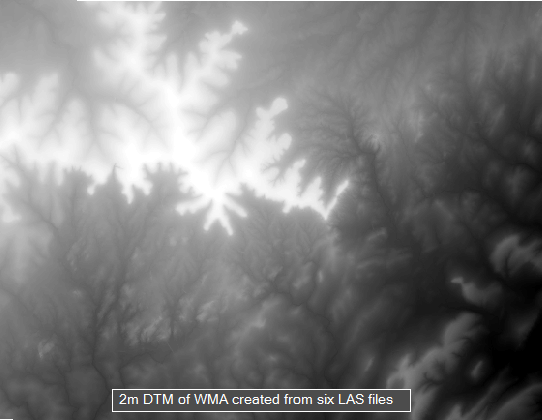
This new DTM will be easier to visualize
in shaded relief.
- Using the Search window, find
the Hillshade tool in ArcToolbox and create a Hillshade.
Your Hillshade should resemble the one below.
Take some time to explore this at higher magnification -
it's an amazing product!
- Load the hillshade_sm file
into your ArcMap project. hillshade_sm is a
~10m
resolution hillshade created from a National Elevation
Dataset (NED; more on this dataset in a later lecture) 10m DEM.
NED data are not derived
from Lidar measurements. As illustrated in the comparison figure
below and from your own observations, the difference is dramatic. Fracture
patterns that are, at best, obscure in the ~10m data are
clearly visible is the 2m DTM.
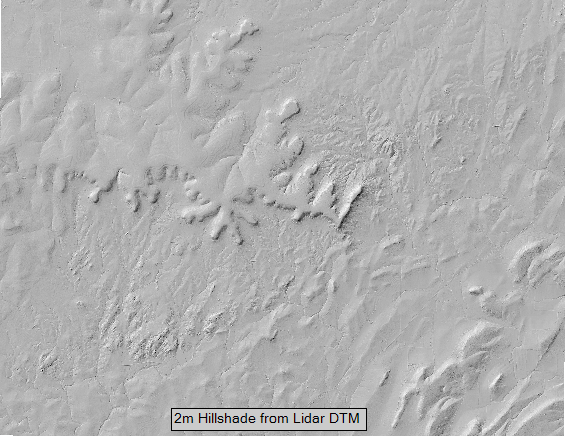
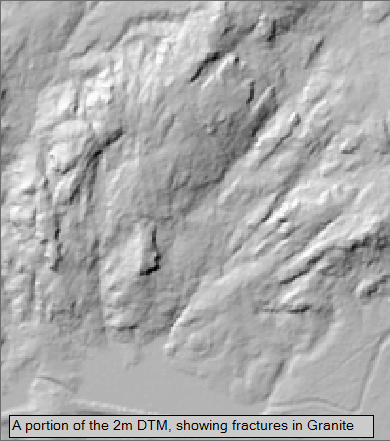 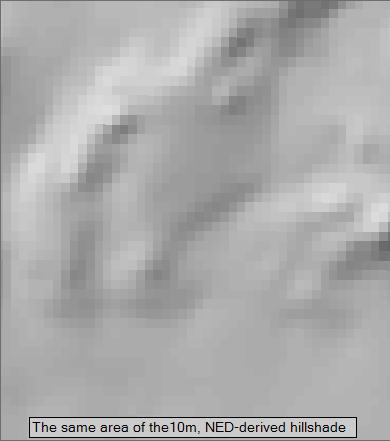
The 2m DTM hillshade exceeds the boundaries of the WMA and is a ~56 Mb
file stored in uncompressed ESRI grid format. We would like a
smaller compressed file for our handheld field units. We can make one by
clipping the file to the WMA boundary and converting the result to a
JPEG image. To do so:
-
Load the "WMA_boundary" file
into ArcMap;
-
Use the "Extract by Mask" tool in
ArcToolbox to clip the DTM hillshade to the WMA boundary
polygon. In so doing, you will have to choose a
file name less than 13 character; I used "clp_hshade"for
my clipped version.
-
This new file is also in ESRI grid
format but is now ~32 Mb (verify this examining the file
Properties>Source tab). This file is still too
large. To compress this new raster:
-
Right click on the
file name in the ArcMap table of
contents, select "Data">"Export data..."
to show the following Export Raster window:
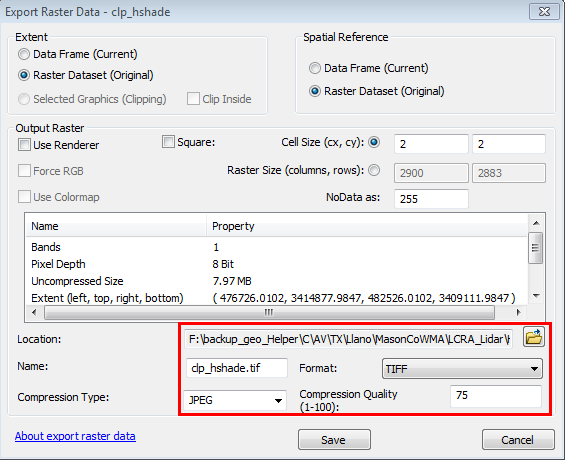
Fill in the fields with the values shown
in the red box above, making sure you save this to a
place where it can be easily retrieved, and click
"Save". This will create a 2m resolution, JPEG
compressed raster, saved in Geotiff format. Through
these processes, we have reduced the file size from ~56
Mb to about 8 Mb without appreciably affecting the utility
of the hillshade! This new Tiff file is now small
enough to store and render on our old handheld units.
8.4 Constructing a Preliminary Map for Field
Work
Base map data for this project are available in shapefile format, but we will find
it useful to build a Geodatabase so that we can
establish domains for data entry. We will be collecting data with ArcPad
software, which permits the capture of GPS positions for points and
vertices and uses forms for entering attributes while in
the field. By using coded value domains in our geodatabase, we can create drop-down menus for our forms, a far easier
way to enter attributes than pecking letters with a stylus on a virtual
keyboard. Recent versions of ArcPad (7.0 and above) also allow the option of
"checking out" Feature Classes from a database for field
editing with ArcPad, then checking them back in
when finished. When it works
properly, this is a very efficient way of editing a field-based GIS,
eliminating the need to update existing files by appending, merging or
otherwise editing them to conform to new field data. You have already done many of the steps
below in Lab 4. Refer to it if you've forgotten aspects
of Geodatabase Feature Class and Domain creation.
- Open ArcCatalog and browse to your Lab_7_data folder.
- Create a personal geodatabase called "Mason_Mt_WMA_XX"
(where XX is your first and last initials) within your Lab_7_data folder.
- Right-click on your new geodatabase and "Import" all of the Feature Classes
(no rasters!) in the
Lab_7_data folder (and subfolders) into the geodatabase. The spatial reference for all of these feature
classes is NAD83, UTM zone 14N, and they will import as such.
- Geodatabases can not hold layer files (these files contain the symbology
for the feature classes you just imported) yet we would like to use the
layer files to symbolize the new geodatabase feature classes. To do so
we must reset the source for the layer files.
Right-click on a layer file icon, select "Properties...", click the
Source tab then the "Set Data Source..." button and reset the source by
browsing to the appropriate Feature Class in your geodatabase. Do this
for all Feature Class layer files (but not raster layer files).
- What about the raster files? The Lab_7_data folder contains two very high resolution DOQs (one multiband color, one single band panochromatic)
with associated layer files and our newly created Lidar 2m hillshade
raster; should we import these into the geodatabase? In
this case the disadvantages of doing so outweigh any advantage. In particular,
the color DOQ is a large MrSID file that would get much larger when uncompressed
and stored in IMG format, which is the format required by the geodatabase. There
is no real advantage to doing this, other than having everything in a single container,
and we are left with a file that is >150 Mb. We could instead create a geodatabase raster index (see
Help files on this topic), but for the few rasters we will work with this also provides no real advantage.
We will keep the rasters separate from the geodatabase for these reasons.
- Time to create the empty Feature Classes that will contain the GPS-derived
points lines and areas...
- Before doing so, it is good practice to create a Feature Dataset
that will contain the new Feature Classes (this is similar to creating a
feature dataset when we digitized in Lab 4; we are digitizing in the
field using a GPS instrument). To do so, right-click on the Mason_Mt_WMA geodatabase
icon, select "New...", then create a new Feature Dataset called "Geology".
SET THE SPATIAL REFERENCE OF THE FEATURE DATASET TO NAD83 UTM zone 14N,
SET THE "Z COORDINATE SYSTEM" TO <None>
AND ACCEPT THE DEFAULT XY TOLERANCES. (Note for outside users: the
procedure for doing this in ArcGIS 9.1 is somewhat different. See
an example here).
- Now we can create the Feature Classes; right-click on the Geology Feature
Dataset icon, select "New...", then create new Polygon, Line and Point
Feature Classes (named Polygon_XX, Line_XX and Point_XX, where XX is your
first and last initial). Do this step 3 times, one for each
Feature Class, being sure to change the Geometry type [polygon, line,
point] to match the Feature Class and checking the
Geometry Properties box on to allow "Coordinates include Z Values"
as shown below.
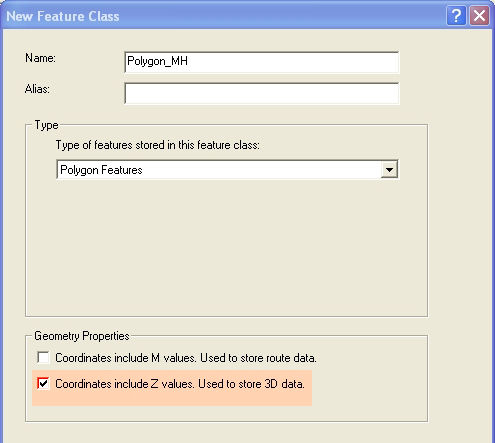
- The polygon feature class will be used to store the GPS-derived
outline of granite outcrops and any other features that are polygons. We need an attribute field that records
the feature being mapped (e.g. "granite", "pegmatite" or “other”) that can be
entered as we collect the data. So... add two Text fields to the polygon feature class, one called
"FEATURE" and another
called "COMMENT". The length of the FEATURE field should be 9 and the COMMENT field 30. Leave all other
Field Properties blank for now. Please use these precise field
names, including capitalization, for this and all other feature classes.
Merging and appending files from different GPS receivers is much easier
if everyone uses exactly the same field names
and properties.
-
Create a Domain (by right-clicking on the Mason_Mt_WMA geodatabase icon, then Properties...) called
PLY_TYPE, (Field Type is Text) that is a coded-value domain containing the coded values of
"granite", "pegmatite", and "other" ( see Lab
4) and then attach this domain to the polygon attribute field FEATURE
( again see Lab 4) .
-
The line Feature Class will be used to store rock unit contacts or
outcrop boundaries that can't immediately be seen to close on themselves
(i.e. can’t be mapped as polygons). The attributes that will be recorded and the new fields
to create are:
i. 9-character text field, called "FEATURE", that will contain coded values from a text Domain called
"LN_TYPE" of "contact",
"outcrop" and "other".
ii. 7-character text field, called "SYMBOL", that will contain coded values from a text Domain called
"Symbol" of "solid",
"dashed" and "dotted".
iii. 30 character text field, called "COMMENT", without an attached domain.
- Create these new Fields and their Domains with the above coded
values and attach the Domains to the Fields, as in steps c and f.
- The point Feature Class will be used to record the location of
features too small to recorded as polygons and for strike and dip
measurements. We will need fields for:
- 10-character text field, called "PT_TYPE", that will contain coded
values from a text Domain called "PT_TYPE" of "joint", "foliation",
"bedding", "dike" and "other".
- 3-character short integer field (Precision equals 3), called "STRIKE",
that will contain coded values from a short integer Domain called
"strike" of every third integers between 0 and 357 (i.e. Codes of 0, 3, 6, 9, 12
etc. with Descriptions of 000, 003, 006, 009, 012,
etc. to 357; yes, all 120 values).
- 2-character short integer field (Precision equals 2), called "DIP", that will contain
coded values from a short integer Domain called “dip” of every second
integer between 2 and 90 (i.e. Codes of 02, 04, 06, etc., with Descriptions
of 02, 04, 06 etc.; 44 values in all).
- 30-character text field, called "COMMENT", without an attached domain.
- Create these new Fields and their Domains with the above coded
values and attach the Domains to the Fields, as in steps c and d.
Congratulations, you have now completed the database you will need for
this project.
8.5 Making Field Maps
- Open ArcMap with an empty map document and load all of the LAYER FILES (not the Feature Classes),
including the layer files for the DOQ and Hillshade. If this doesn't
work, you skipped Step 5 above.
- Load your empty polygon_XX, line_XX and point_XX Feature Classes you just
created and move them to the top of the Table of Contents if not already
there.
- Order the remaining layers so that the Hillshade is at the bottom, the DOQ
is second from the bottom, and all remaining layers above these.
- Set the Display Properties of the rock units and the
outcrop polygons to 50% transparent.
- Zoom to the WMA boundary layer, reset the reference scale, and
SAVE THE MAP document to your Lab_7 folder.
Switch to Layout mode and make a map with a 50 meter UTM grid, scale bar, north arrow, name, etc. Print two maps, one with the hillshade layer turned on and another with the hillshade off
but the DOQ on. The scale should be ~ 1:10,000 to be useful; you will have
to tile the map onto a few pieces of paper to cover the area of interest
(Margo will tell you how much of the area to print), which is within the portion of the WMA
that is within granite southeast of Mason Mountain and along the western
boundary within granite.
Bring these maps with you on the field trip.
8.6 Trimble Nomad and ArcPad v. 10
GPS data collection using the Trimble Nomad units is done with ArcPad software. ArcPad is a streamlined version of ArcGIS
that is equipped with very easy to use GPS capture tools. ArcPad 10 is
installed on the classroom computers and our field data collection units. Version
10 is a major revision
from earlier releases. Before getting a little ArcPad
practice, we first need to convert the ArcGIS map document file into an
"ArcPad Project". An automated tool exists to do so, which converts
most rasters to jpeg images, the geodatabase to an ArcPad exchange format
database (.AXF),
and makes data entry forms from the domains for each Feature Class.
We can "check out" the empty Feature Classes for editing then, upon
return, "check in" the same, permitting the software to automatically
update the geodatabase!
An important note about ArcPad versions:
- ArcPad 10 represents a significant departure from earlier
versions (i.e. 8.x and below). "ArcPad Projects" created for ArcPad
10 will not run on 6.x software, and vice-versa.
The ArcMap toolbar for creating ArcPad projects in versions of
ArcGIS 9.1 and higher contains separate tools for creating ArcPad 8.x and 6.x (or lower) projects. It is thus important to know
which version of ArcPad is installed on your field data collection
units. Our Trimble Nomads and Xplore tablet PCs are
currently running ArcPad 10, as are
the computers in the lab.
A. Preparing the Map Document for ArcPad (version 10).
- Open your map document.
- Switch to Data View mode
(if you're in Layout mode) and zoom to your
Hillshade layer. This is an important step!
- Make sure the "Point"
and Rock Unit contacts Feature Classes
are present in the Table of Contents of the map. These have coded-value domains already
built that will allow use of ArcPad data entry forms. These are
the files you will populate with GPS measurements.
- Change the symbology of these files to colors/symbols that will
be recognizable on both a white background and the DOQ. Red works
well, as does light blue. This is much easier to do now than later
in ArcPad.
- If not already on, Turn on the ArcPad Data Manager
toolbar (Tools>customize...) shown below.
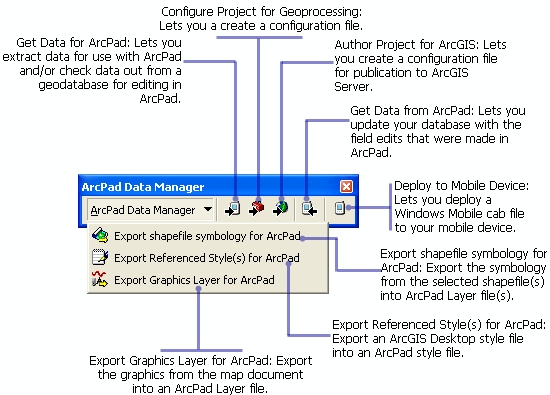
- On the ArcPad toolbar, click the "Get Data for ArcPad" button.
In the "Select Data"
window, shown below, there are several options for how to export data
under the "Action" column. The "action" performed
on each layer can be set individually or for all layers
by clicking on the word "Action" to display the menu
shown in the figure below. Strictly speaking, we
can either "Checkout" a layer for editing or "Copyout" a
layer. A "Checkout" is only allowed for Geodatabase
layers; shapefiles or other layers not in a geodatabase
can be "Copied Out". A "Checkout" creates a compact
geodatabase that can only be read by ArcPad in a so-called "AXF"
(Arc Pad Exchange Format) file. There are
numerous advantages to AXF files - read about them on
page 573 of the ArcPad Help PDF in the Lab 7_data
folder. For our purposes, the principal advantage
is the automatic creation of forms (based on our geodatabase domains)
that can be edited in the field, and the ability to directly import the
results into our ArcGIS project after returning from the field.
The main disadvantage is that a Checkout is tied to a specific ArcGIS
file, your project, on a specific computer. After data
collection, the file can only be checked into your
project (into your
geodatabase) on the computer you created it on. An AXF file can
not be edited by any software, so if you are unable to check it back in,
for whatever reason, you've lost all of your field results.
The other option, "Copyout", creates a Shapefile that can be read by ArcPad. Unfortunately, this option does not automatically create
forms for field editing, nor can results be directly checked back into
your ArcGIS file after field work is done. The shapefiles can,
however, be downloaded from the receiver onto a computer and loaded into
your ArcGIS project by the same process you would use to load any other
shapefile. "Copyout" layers are exported to ArcPad as "background
layers" that either can be editable or not.
We will cover several bases by "Checking Out" the three files we will
edit in the field (Points, Rock unit contacts), "Copyout"
the other Feature Classes (those we will
not edit) as "read-only" background
shapefile. I will explain the rationale during lecture. To
do this requires specifying the "action" for each layer individually.
- Click the black arrowhead to the left of your "Points_XX"
Layer and choose "Checkout for disconnected editing in ArcPad>data based
on defined extent". Do the same for the Line_XX and
Polygon_XX
layers.
- For all other vector layers choose "Export
as Background data (to Shapefile)>Make Read
Only"
- The only
raster file we will export is
the clipped 2m Lidar hillshade. For
this layer choose "Export as background
using the original raster". Do not
export any other rasters, they are too large
to open on our handheld units, even when
compressed!
- Click Next.
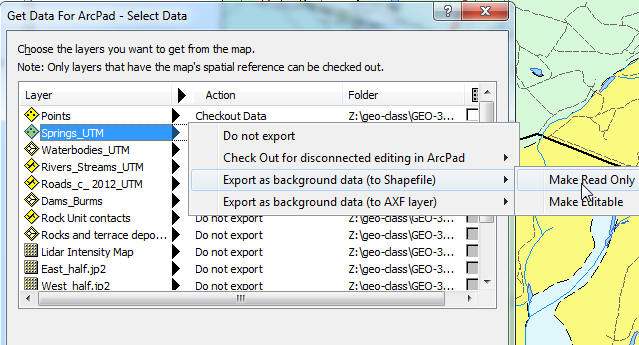
- The next window, "Select Picture Options", is not
applicable to this project; Click Next.
- The final window lets you set the spatial extent (current
display extent or full extent of the layers), lets you select whether to
limit the fields to those that are visible in the attribute tables and
the features to those specified in the layer's definition query, lets
you specify a name for the folder that will store the data, and lets you
create an ArcPad map file (the equivalent of an .mxd file) for the data,
as shown in the "Get Data For ArcPad" screen capture below.
- Enter a name for the folder, e.g. "ArcPad_WMA_XX" (where
XX are your initials) and a
Map Name that includes your last name or initials (e.g. WMA_XX).
- Making sure first that your display shows the entire area of
interest (i.e. you are zoomed to the area of interest), make the selections shown in the figure below, setting the
"Where do you want the folder to be stored?" to an appropriate location
on your flash drive.
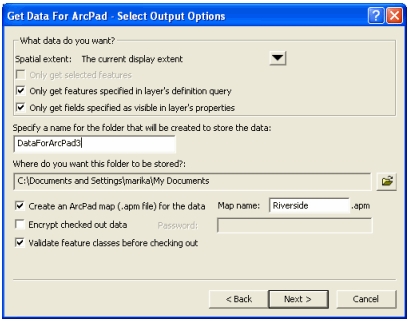
- Click Finish and wait for the data to be created.
- With help from me or
Margo, transfer your new "ArcPad_RR_XX" folder
to your Trimble Nomad (these will be shared, but each partner can load a
project). The Nomad units have a folder called "My
Documents" that should be used for all ArcPad
data and files.
- Print a color copy of the PDF file "ArcPad Quick Reference", in color,
from All Programs>ArcGIS>ArcPad 10>Help>ArcPad Quick Reference.
You will find this exceptionally useful for Part B of this lab, and for
the field trip.
PART B
Practice with ArcPad in the field
8B.1 Using ArcPad - some practice with the basics
Editing in ArcPad is, in most ways, much simpler than Editing in ArcGIS.
The basic concept is the same in both - data are entered into a file that
is open for editing. Below are a few of the basics. A complete description of the
software can be found in the ArcPad 10 folder in the class folder.
- On a classroom computer, open ArcPad 10 from the Start Button>All Programs menu in Windows.
If needed, enter one of the license codes
available in the Lab_7_data folder.
- Click the folder button at the top of the ArcPad window and select
"Open Map", then browse to your ArcPad map file, the one with
the ".apm" extension, in your "ArcPad_RR_XX" folder.
- Five toolbars are immediately available (called Main
Tools, Browse Tools Edit Tools Quick Capture and Navigation), though
only one at timeis displayed (this saves real estate on small
screens).
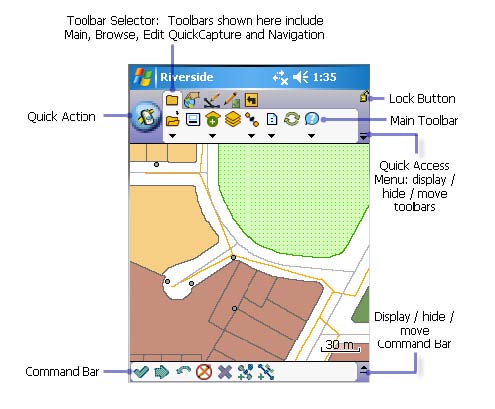
- Click the Main Tools icon (on the left in the figure above) and then
select the Layers icon
 to
open up a Table of Contents, like that on the left below. The
diagram on the right, from an earlier version of ArcPad, has many of the
icons labeled. to
open up a Table of Contents, like that on the left below. The
diagram on the right, from an earlier version of ArcPad, has many of the
icons labeled.
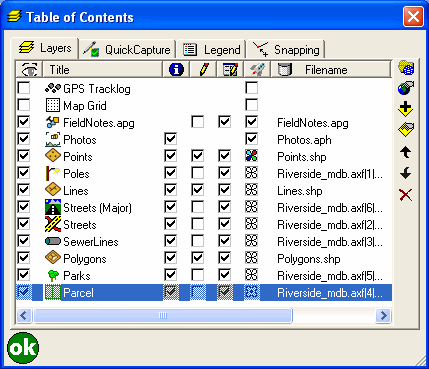 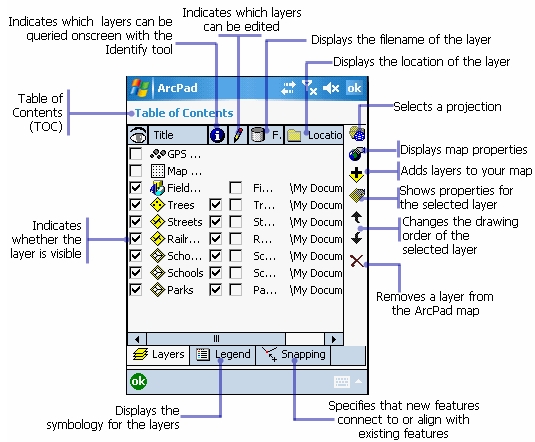
-
The check boxes on the left in the "eye" column turn
layers on and off for viewing. The check boxes in the "pencil"
column turn layers on and off for editing. This is similar
to setting the "Target" of the editing toolbar in ArcGIS, except that
in ArcPad more than one layer can be open for editing at a time. In
the Table of Contents to the right above, none of the layers are open for
editing. In the table of contents on the left above three layers
(Point, Line, Polygon) are open for editing. Finally, the check boxes below the Info icon (i) make layers available for query.
Layer Properties can be accessed by an icon on the right, as can other
options denoted by icons that should be familiar from ArcMap. The
column with the "rocket ship" icon at the top is the QuickDraw mode;
checking boxes here allows the different layers to be drawn to different
"coarseness" so they will render quicker on screen. The QuickDraw
mode is accessed from the Editing Toolbar.
-
Turn on the "Point_XX" layer for editing and close the
Table of Contents.
-
Turn on the Edit toolbar by selecting it from top row of
icons, as shown below.
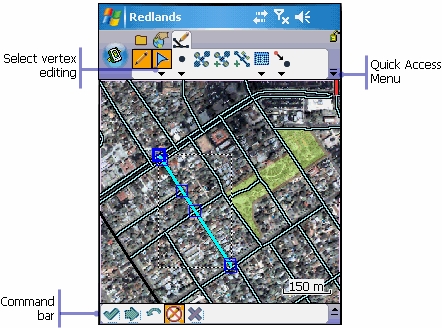
-
The function of the edit tools are shown in the figure
below. This is the most important toolbar for the field work
this weekend. Learn it.
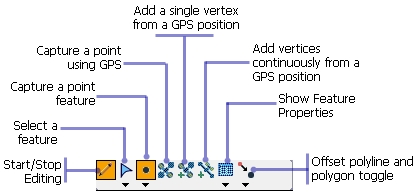
To add a point to the map, Click the pencil tool, select
the layer you want to edit, click the "Capture a point
feature" button, (Capture of polyline or polygon features, if open
for editing in the TOC, can be selecting from the drop-down menu below
the "capture a point" feature icon). Then click a location on the map. A data entry form should then open,
allowing you to select the feature name from a drop down list.
To do outdoors: To add a GPS location as a point, click instead the
"Capture a point using GPS" button. (When the GPS is active this
button is not grayed-out.)
-
To add a line, click the Pencil icon, select the polyline
feature class you want to edit, click the drop-down arrow below
to the "Capture a point feature" button, and select "Polyline".
Click on the map where you wish to place a polyline vertex, click and drag
on the next spot where you want a vertex, and continue this process until
finished. The line is not completed until you click the "Proceed
or complete feature" button at the bottom of the ArcPad window
(shown below).

-
To do outdoors: To add GPS vertices to a polyline, as above, click the "Capture a polyline"
button (beneath the capture a point button), click the "Add a single
vertex from a GPS position" button and continue clicking this button
every time you want to add a vertex to the line. To finish the
line, click the "Proceed or complete feature" button, the
green arrow icon. The line is not completed until you click the
"Proceed or complete feature" icon.
The GPS must be activated before
the GPS buttons are available.
-
A similar procedure is used to capture polygon vertices
with and without GPS.
-
You can delete features by selecting them with the
Arrow button (shown above) and then
clicking the "Edit vertices" button.
-
Practice adding and deleting lines, points and polygons to the map.
Name the features test1, test2, etc. so that, if needed, you will be able to recognize and
delete them later.
-
Browse the ArcPad manual in the digital books folder,
particularly the sections on editing. Download and print the
ArcPad Quick Reference
page.
-
Before loading your ArcPad folders to the field GPS
units, clear each of your test features, or don't save your project after
editing.
8B.2
-
Before our field trip, you need practice using ArcPad with a GPS.
An ArcPad project for the Main Building area, identical to the ArcGIS project
you constructed in Lab 6, is loaded on all instruments. Take
your instrument outside, open the Main Building project, and practice
capturing lines, points and polygons using the ArcPad GPS
tools described above.
-
Specifically, capture the features listed and
labeled in the photo below.
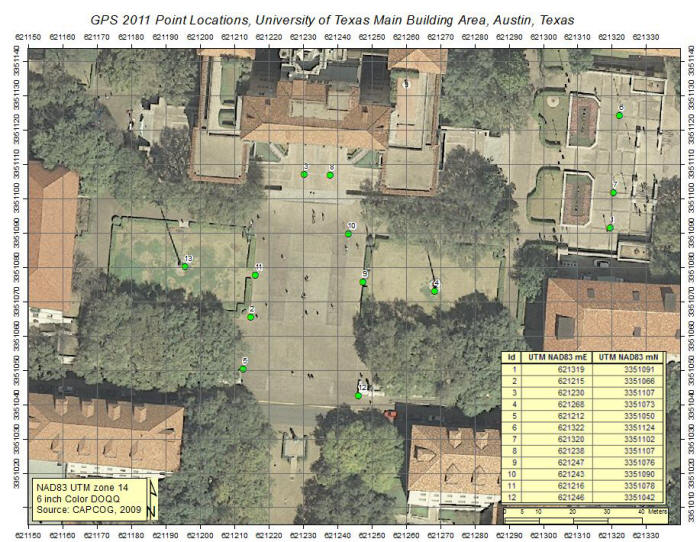
- Points: Points at the two flagpoles.
- L1, L2, L3: Polylines with at least 3 GPS vertices at the edges of
sidewalks.
- P1, P2: Polygons outlining grass areas - capture the vertices
of the 4 corners with
GPS. s - capture the vertices
of the 4 corners with
GPS.
You're done.
|
 |